Optimize Your Health: The Power of Enhanced Nutritional Intralipid IV Therapy

Introduction to Intralipid Therapy
Definition of Intralipid Therapy
Intralipid therapy is a form of intravenous nutrition that involves the administration of a lipid emulsion containing essential fatty acids and calories to individuals who are unable to consume an adequate amount of nutrients orally. This therapy is crucial for patients who have difficulty absorbing nutrients due to gastrointestinal disorders or those who require additional nutritional support during hospitalization.
Purpose of Intralipid Therapy
The primary purpose of intralipid therapy is to provide essential nutrients, specifically fatty acids and calories, to individuals who are at risk of malnutrition or nutritional deficiencies. By delivering these vital components directly into the bloodstream, this therapy ensures that the body receives the necessary fuel for optimal functioning and healing.
Brief Overview of Use in Nutritional Support
Intralipid therapy plays a significant role in supporting the nutritional needs of hospitalized patients, especially those with gastrointestinal disorders that impair nutrient absorption. By bypassing the digestive system and delivering nutrients directly into the bloodstream, this therapy ensures that patients receive the essential components needed for recovery and overall health.
- For hospitalized patients: Intralipid therapy can be a lifeline for individuals who are unable to consume food orally, providing them with the necessary nutrients for energy and healing.
- For individuals with gastrointestinal disorders: Intralipid therapy can help compensate for malabsorption issues, ensuring that essential fatty acids and calories are delivered effectively.
By understanding the definition and purpose of intralipid therapy, we can appreciate its critical role in enhancing the nutritional status and well-being of individuals facing challenges in nutrient absorption and consumption. Through this therapy, patients can receive the support they need to promote healing, recovery, and overall health.
Sources: – National Center for Biotechnology Information
Nutritional Benefits of Intralipid

Provision of Essential Fatty Acids and Calories
Intralipid therapy plays a crucial role in providing essential fatty acids and calories to individuals who are unable to consume or absorb nutrients orally. Essential fatty acids are vital for various functions in the body, including cell membrane structure, hormone production, and inflammation regulation. By delivering these essential fats intravenously, Intralipid ensures that patients receive the necessary building blocks for optimal health and well-being.
Source:
American Society for Parenteral and Enteral Nutrition
Role in Preventing and Treating Malnutrition and Nutritional Deficiencies
Malnutrition and nutritional deficiencies can have serious consequences on overall health and recovery. Intralipid therapy helps prevent and treat these conditions by supplying a concentrated source of calories and essential nutrients directly into the bloodstream. This method bypasses the digestive system, ensuring that patients receive the necessary nutrition even when oral intake is not feasible.
Source:
National Center for Biotechnology Information
Ensuring Adequate Nutrient Intake
For individuals with gastrointestinal disorders or those undergoing post-surgical recovery, maintaining adequate nutrient intake can be challenging. Intralipid therapy bridges this gap by providing a convenient and effective way to deliver essential nutrients, promoting healing and supporting the body’s nutritional needs during critical periods.
Source:
Supporting Overall Health and Well-Being
By addressing nutritional deficiencies and supporting healthy calorie intake, Intralipid therapy contributes to improved overall health and well-being. Patients receiving this form of nutritional support may experience enhanced energy levels, better immune function, and improved outcomes in their recovery journey.
Source:
Indications for Intralipid Therapy

Short Bowel Syndrome and Other Gastrointestinal Disorders
Individuals suffering from short bowel syndrome and various gastrointestinal disorders often face challenges in properly absorbing essential nutrients from food. This can lead to malnutrition and deficiencies in vital elements crucial for overall health. Intralipid therapy becomes a valuable solution in such cases, providing these individuals with the necessary fatty acids and calories directly through intravenous administration.
Post-Surgical Recovery and Inability to Consume Adequate Nutrients Orally
After undergoing surgical procedures, some patients may have difficulty consuming an adequate amount of nutrients orally due to factors like decreased appetite, pain, or gastrointestinal complications. Intralipid therapy proves beneficial during this critical post-surgical recovery phase by ensuring that these individuals receive essential nutrients intravenously, supporting their healing and recovery processes effectively.
Critical Illness and Hospitalization with Increased Nutritional Needs
During times of critical illness or extended hospitalization, individuals often experience heightened nutritional requirements to support their immune system, aid in recovery, and maintain overall health. Intralipid therapy plays a crucial role in meeting these increased nutritional needs by delivering essential fatty acids and calories directly into the bloodstream, bypassing the digestive system and ensuring optimal nutrient absorption.
- Short bowel syndrome and gastrointestinal disorders can hinder nutrient absorption, making intravenous nutrient delivery essential.
- Post-surgical patients may struggle to consume nutrients orally, necessitating intravenous nutritional support for optimal recovery.
- Critical illness and extended hospital stays increase nutritional demands, which can be effectively met through intravenous administration of nutrients.
By addressing these specific indications for Intralipid therapy, healthcare professionals can ensure that individuals with short bowel syndrome, gastrointestinal disorders, post-surgical recovery needs, and increased nutritional requirements due to critical illness receive the essential nutrients they need for improved health and well-being. Source: Example Medical Journal
Administration and Monitoring

Intravenous Administration and Dosing Considerations
Intralipid therapy is typically administered intravenously to ensure the direct delivery of essential fatty acids and calories into the bloodstream. The dosing of Intralipid is based on the individual’s nutritional needs, medical condition, and response to treatment. Healthcare professionals carefully calculate the appropriate dosage to meet the patient’s specific requirements, taking into account factors such as weight, nutritional status, and the underlying reason for therapy.
Monitoring for Potential Side Effects and Complications
Monitoring is a critical aspect of Intralipid therapy to ensure the patient’s safety and well-being. Healthcare professionals closely monitor patients receiving Intralipid for any potential side effects or complications that may arise during treatment. Common side effects may include allergic reactions, hyperlipidemia, and abnormalities in liver function tests. Monitoring allows for prompt identification and management of these issues to optimize the effectiveness of therapy.
Importance of Proper Technique and Healthcare Professional Supervision
Proper technique in the administration of Intralipid is essential to prevent complications and ensure the therapy’s success. Healthcare professionals undergo training to accurately prepare and administer Intralipid, following strict guidelines to maintain sterility and safety. Additionally, continuous supervision by healthcare providers is crucial to monitor the patient’s response to treatment, adjust dosages as needed, and address any concerns or adverse reactions promptly. Overall, the administration and monitoring of Intralipid therapy play a pivotal role in its effectiveness and safety for patients with short bowel syndrome, gastrointestinal disorders, post-surgical recovery needs, and critical illnesses with increased nutritional demands. By adhering to proper techniques, closely monitoring for side effects, and under the supervision of healthcare professionals, individuals can experience the full benefits of Intralipid therapy in enhancing their nutritional health and overall well-being. Source: National Center for Biotechnology Information
Patient Outcomes and Quality of Life

Improved Nutritional Status and Overall Health
One of the key benefits of utilizing Intralipid therapy is the significant improvement it brings to the nutritional status and overall health of individuals. By providing essential fatty acids and calories intravenously, this therapy ensures that patients receive the necessary nutrients they may not be able to absorb or consume orally. This leads to a boost in energy levels, enhanced immune function, and better overall well-being.
Enhanced Recovery and Healing Processes
Through the provision of vital nutrients directly into the bloodstream, Intralipid therapy accelerates the recovery and healing processes in individuals undergoing treatment. Whether recovering from surgery, managing a gastrointestinal disorder, or dealing with critical illness, the infusion of essential fatty acids plays a crucial role in promoting tissue repair, reducing inflammation, and supporting the body’s regenerative abilities.
Increased Quality of Life for Individuals with Chronic Conditions
For individuals with chronic conditions that impact their ability to consume or absorb nutrients effectively, Intralipid therapy offers a lifeline by ensuring they receive the essential nutrition needed for daily functioning and overall health. By alleviating the burden of malnutrition, this therapy not only improves physical well-being but also enhances mental clarity, emotional resilience, and quality of life.
Sources: Source Title,
Duration of Intralipid Effects in the System

When considering intralipid IV therapy for fertility, one common question is, “How long do intralipids stay in your system?” The effects of intralipid on the immune system can last between 6 and 9 weeks following three infusions. This duration is crucial for maintaining a supportive environment for embryo implantation and early pregnancy development. The lipid emulsion works by deactivating natural killer (NK) cells, which are part of the body’s immune response that can sometimes interfere with successful pregnancy outcomes.
Intralipid therapy is typically administered starting one to two weeks before an IVF embryo transfer, with subsequent infusions continuing through the first trimester of pregnancy. This schedule ensures that the immune-modulating effects of intralipids are sustained during the critical early stages of pregnancy, thereby enhancing the chances of a successful implantation and reducing the risk of miscarriage. Understanding the duration of intralipid’s effects helps in planning and optimizing fertility treatments for better outcomes.
If you are interested in requesting Intralipid IV therapy with In Home Infusion, please text or call us at 442-216-0948.


